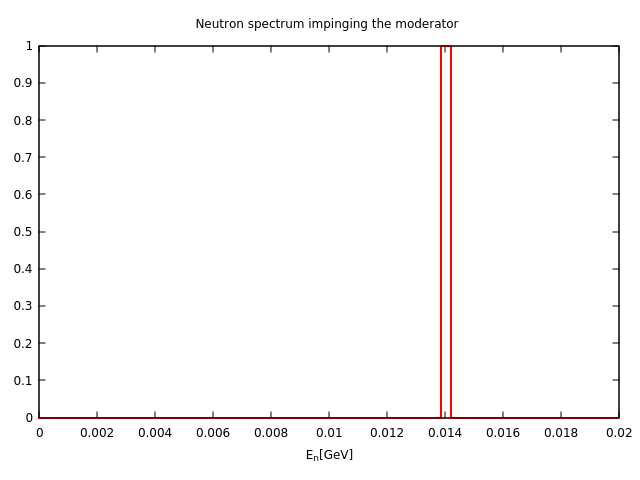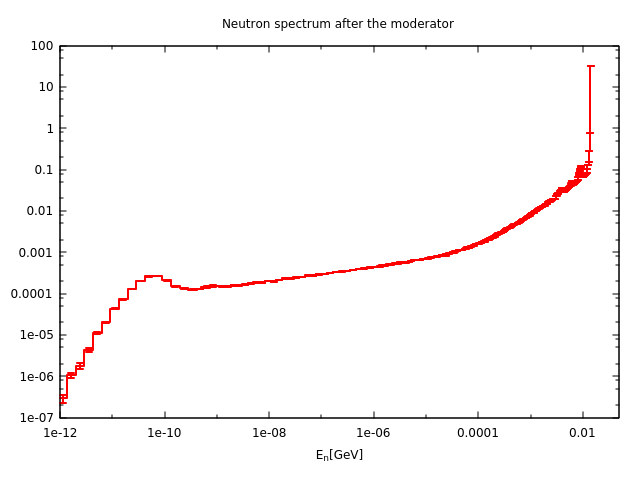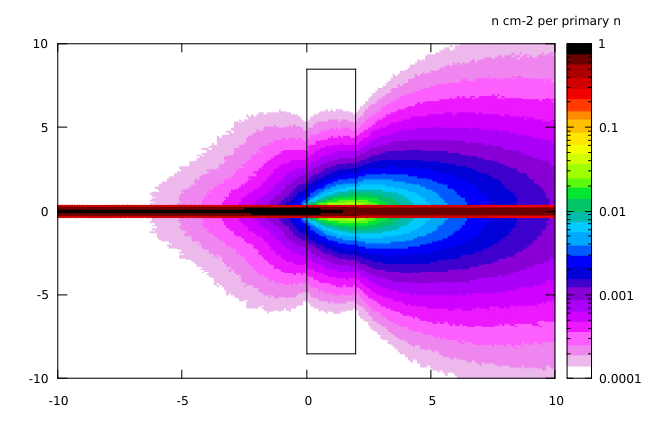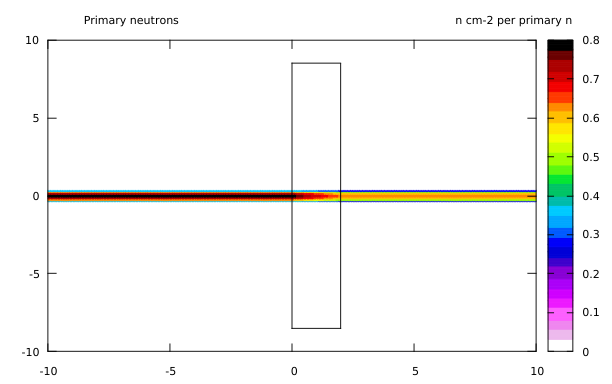Date: Thu, 16 Jul 2020 20:52:49 +0200
Dear Sizwe,
in your simulation you find exactly what you should expect!
Let's go step by step.
You send a 14 MeV neutron beam towards a polyethylene target. You are
using the USRBDX card to score the neutron fluence (and maybe you are
interested in the neutron yield) exiting the target, as well -I can see- to
check the neutrons impinging the target. I plotted the results using your
card, and adding another USRBDX card to score the neutron current instead of
the neutron fluence (to obtain the neutron spectrum the difference is in
this case irrelevant, but if you want to count neutrons you want to avoid
the 1/cos(theta) weight). When you plot the results using your [ ]_tab.lis
file, remember that there the bin content is given per GeV (and per
primary). To obtain the yield you have therefore to multiply the bin content
by the bin width. For example, if you plot the first neutron spectrum as
Y*DX, you obtain exactly one bin (centred on 14 MeV) with content 1.
When you look at the neutrons exiting the target, you expect to see the
effect of elastic and inelastic scattering in the polyethylene. In your
output file PE-2cm00#.out (always give a look at this!), you find the
contribution from the secondaries:
Number of secondaries created by low energy neutron per beam particle:
Prompt radiation Radioactive decays
5.5729E-01 (100.%) 0.0000E+00 (100.%)
3.5838E-01(64.3%) 0.0000E+00 ( 0.0%) NEUTRON
0.0000E+00 ( 0.0%) 0.0000E+00 ( 0.0%) fission NEUTRON
1.8070E-01 (32.4%) 0.0000E+00 ( 0.0%) PROTON
1.8209E-02 ( 3.3%) 0.0000E+00 ( 0.0%)PHOTON
1.0179E-05 ( 0.0%) 0.0000E+00 ( 0.0%) DEUTERON
0.0000E+00 ( 0.0%)0.0000E+00 ( 0.0%) TRITON
0.0000E+00 ( 0.0%) 0.0000E+00 ( 0.0%) 3-HELIUM
5.1815E-02 ( 9.3%) 0.0000E+00 ( 0.0%) 4-HELIUM
As you can see, you have 3.58 secondary neutrons every 10 primaries. You see
the spectrum of the exiting neutrons, with the expected nice thermal peak,
plotting your second USRBDX card.
An observation: in the USRBDX you required a linear binning for the scored
neutrons, but below 20 MeV the multi-group treatment forces the binning to
follow the 260 predefined (logarithmic) energy groups.
Last: I suggest you -it can be useful- to put always in your simulation one
or more USRBIN cards, to understand the general behaviour of the radiation.
In attachment you can see the behaviour of the neutron fluence averaged in a
narrow volume containing the plane which cuts the axis of your moderator: in
NeuFlu.png you can see the whole neutron fluence (primaries and secondaries
until the 0.1 permil level), while in BeamPart.jpg you can see the behaviour
of the primary neutrons (included the beam attenuation in the target).
To reproduce this plots you can add these cards (please check the spacing!):
* To check fluence
USRBIN 10.0 NEUTRON -25.0 10.0 1.0 10.0 NeuFlu
USRBIN -10.0 -1.0 -10.0 200.0 1.0 200.0 &
*
USRBIN 10.0 BEAMPART -26.0 10.0 1.0 10.0 BPFlu
USRBIN -10.0 -1.0 -10.0 200.0 1.0 200.0 &
*
An additional tip: you don't need the LOW-NEUT card, with your default the
interaction and transport of low energy neutrons are switched on (see
manual!).
Hope this helps,
Anna
Am Thu, 16 Jul 2020 09:08:28 +0200 schriebSIZWE SCELO MHLONGO
<3698012_at_myuwc.ac.za>:
>Dear FLUKA experts,
>I am simulatinga neutron beam that impinges on a polyethylene target and am interested in the neutron fluence that comes out on theother end of the target (I use USRBDX to score).
>What I have observed is that for a 2-4 cm thick target there areadditional neutrons in the beam, which is not expected. The same is observed for water; what could be the possibleexplanation for this? I have attached my input file below. Thanks.
>Best regards,
>Sizwe
>
>
>
>
>Disclaimer - This e-mail is subject to UWC policies and e-mail disclaimer published onour website at: https://www.uwc.ac.za/Pages/emaildisclaimer.aspx
>
------------------------------------------------------------------------------------
Dr. Anna Ferrari
Institute of Radiation Physics, High Energy Density Division
Helmholtz-Zentrum Dresden-Rossendorf e.V.
Bautzner Landstraße 400, D-01328 Dresden
Tel. +49 351 260 2872
http://www.hzdr.de
http://www.hzdr.de
Vorstand: Prof. Dr. Sebastian M.Schmidt, Dr. Ulrich Breuer
Vereinsregister: VR 1693 beim Amtsgericht Dresden
__________________________________________________________________________
You can manage unsubscription from this mailing list at https://www.fluka.org/fluka.php?id=acc_info

(image/png attachment: PE-2cm_23_plot.png)

(image/png attachment: PE-2cm_23_plot01.png)

(image/png attachment: NeuFlu.png)

(image/png attachment: BeamPartFlu.png)
- application/x-pkcs7-signature attachment: smime.p7s